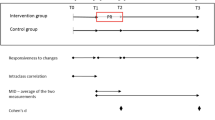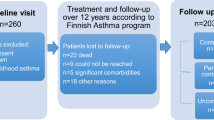Abstract
The quality of life (QOL) benefits of salmeterol versus placebo were compared in a double-blind, multicentre study using the Living with Asthma Questionnaire (LWAQ) which was scored in three different ways. First, the overall LWAQ score showed that salmeterol enhanced QOL compared to placebo. Second, when the LWAQ was analysed in terms of its two construct subscales we found, as predicted previously, that the Problem construct was more sensitive to longitudinal change compared with the Evaluation construct. Third, when the LWAQ was analysed in terms of its 11 domain subscales we found a significant improvement for salmeterol compared with placebo on three domains, Sport, Sleep, and Work and other activities. Analysing clinical trial results in terms of construct subscales and domain subscales provides different kinds of information each of which is useful. Analysis in terms of overall QOL scores is less informative.
Similar content being viewed by others
References
Hyland ME. The validity of health assessments: resolving some recent differences. J Clin Epidemiol 1993; 46: 1019–23.
Anastasi A. Psychological Testing, 6th edn. New York: Collier Macmillan, 1988.
Nunnally JC. Psychometric Theory, 2nd edn. New York: McGraw-Hill, 1978.
Ware JE. Standards for validating health measures: definition and content. J Chronic Dis 1987; 40: 473–80.
Bergner M, Bobbit RA, Carter WB, Gilson BS. The Sickness Impact Profile: development and final revision of a health status measure. Med Care 1981; 19: 87–805.
Ware JE, Sherbourne CD. The MOS 36-item Short-Form Health Survey (SF-36). Med Care 1992; 30: 473–83.
Hunt SM, McEwen J, McKenna S. Measuring Health Status. London: Croom Helm, 1986.
Kaplan RM, Bush JW. Health-related quality of life measurement for evaluation of research and policy analysis. Health Psychol 1982; 1: 61–80.
Hyland ME. Selection of items and avoidance of bias in quality of life scales. PharmacoEconomics 1992; 1: 182–90.
Rosser RM, Watts VC. The measurement of hospital output. Int J Epidemiol 1972; 1: 361–8.
Lazarus RS, Smith CA. Knowledge and appraisal in the cognition-emotion relationship. Cognition Emotion 1988; 2: 281–300.
McHorney CA, Ware JE, Raczek AE. The Mos 36 item Short-Form Health Survey (SF-36). 2. Psychometric and clinical tests of validity in measuring physical and mental health constructs. Clin Care 1993; 31: 247–63.
Hyland ME. A reformulation of quality of life for medical science. Quality Life Res 1992; 1: 267–72.
Guyatt GH, Kirshner B, Jaeschke R. Measuring health status: What are the necessary measurement properties? J Clin Epidemiol 1992; 45: 1341–5.
Hyland ME, Finnis S, Irvine SH. A scale for assessing quality of life in adult asthma sufferers. J Psychosom Res 1991; 35: 99–110.
Palmer JBD, Hyland ME. Salmeterol in clinical practice: comparator and safety studies, quality of life studies. Eur Resp Rev 1991; 4: 301–3.
Hyland ME, Thompson P, Bellesis M, Kenyon CAP. Quality of life consequences of morbidity reduction in asthma: health-knowledge versus health-appraisal. Submitted for publication.
Gorsuch RL. Common factor analysis versus component analysis: some well and little known facts. Multivariate Behav Res 1990; 25: 33–9.
Taylor IK, O'Shaughnessy KM, Choudry NB, Adachi M, Palmer JBD, Fuller RW. A comparative study in atopic subjects with asthma of the effects of salmeterol and salbutamol on allergen-induced bronchoconstriction, increase in airway reactivity, and increase in urinary leukotrien E4 excretion. J Allergy Clin Immunol 1992; 89: 575–83.
Lotvall J, Svedmyr N. Salmeterol: an inhaled beta-2 agonist with prolonged duraction of action. Lung 1993; 171: 249–64.
Kaplan R, Saccuzzo DP. Psychological Testing: Principles, Applications, and Issues. 2nd edn. Pacific Grove, CA: Brooks Cole, 1989.
Author information
Authors and Affiliations
Rights and permissions
About this article
Cite this article
Hyland, M.E., Kenyon, C.A.P. & Jacobs, P.A. Sensitivity of quality of life domains and constructs to longitudinal change in a clinical trial comparing salmeterol with placebo in asthmatics. Qual Life Res 3, 121–126 (1994). https://doi.org/10.1007/BF00435255
Received:
Accepted:
Issue Date:
DOI: https://doi.org/10.1007/BF00435255




